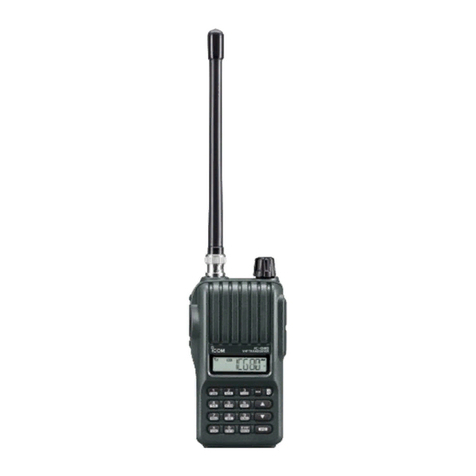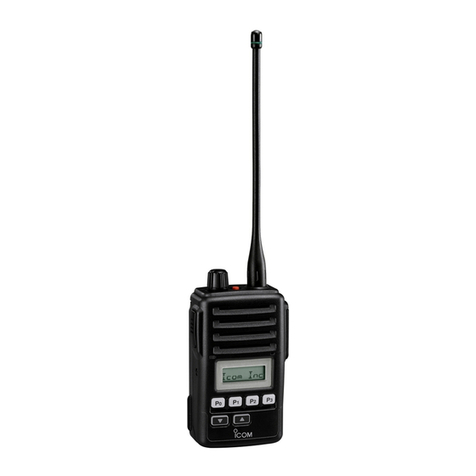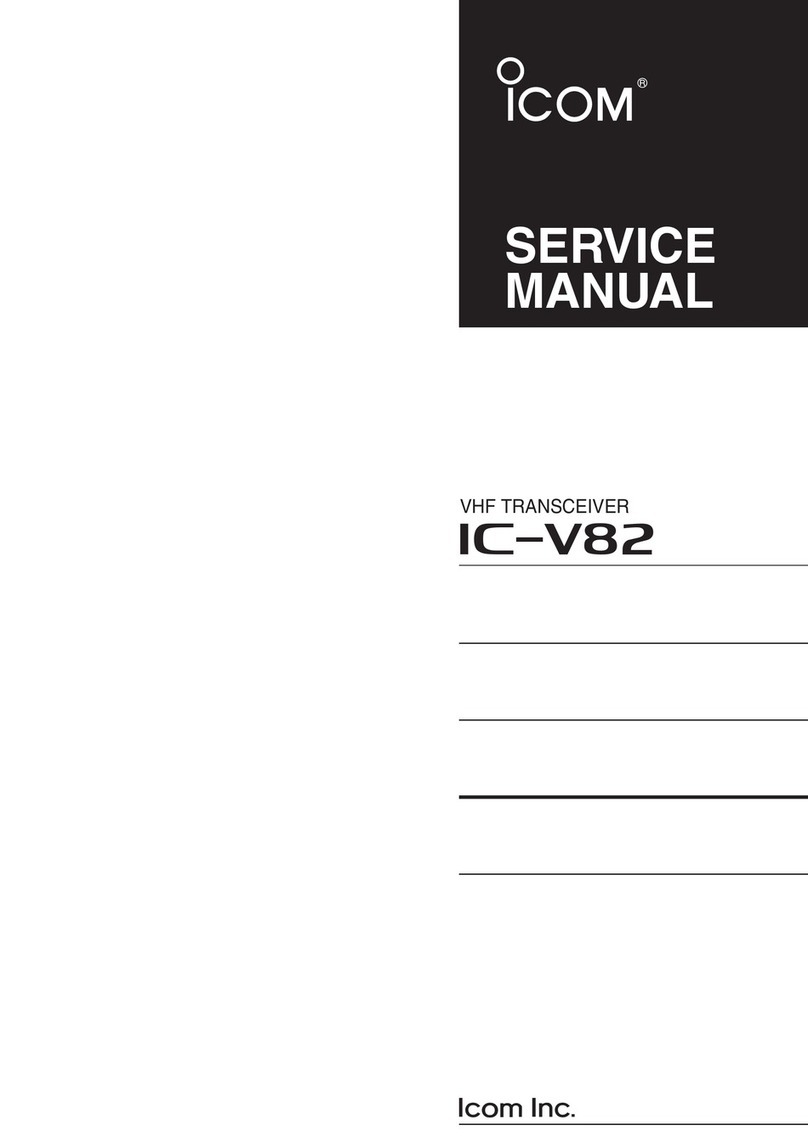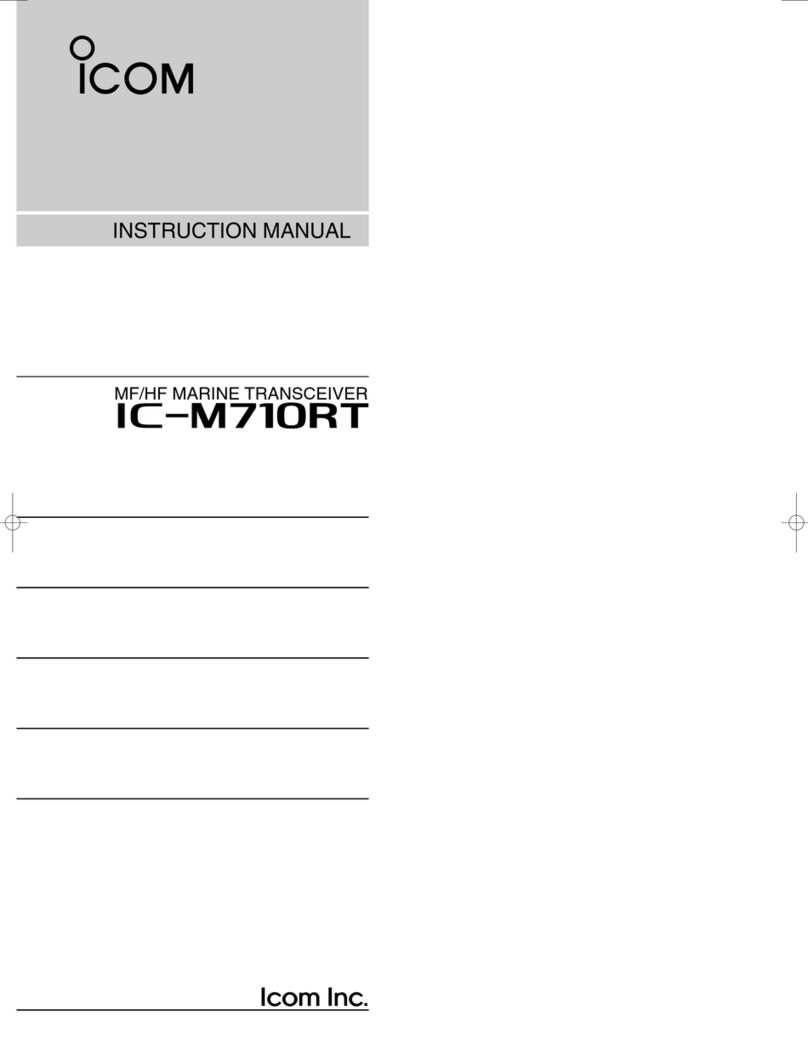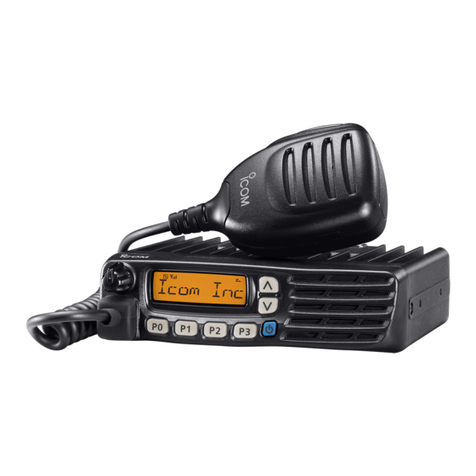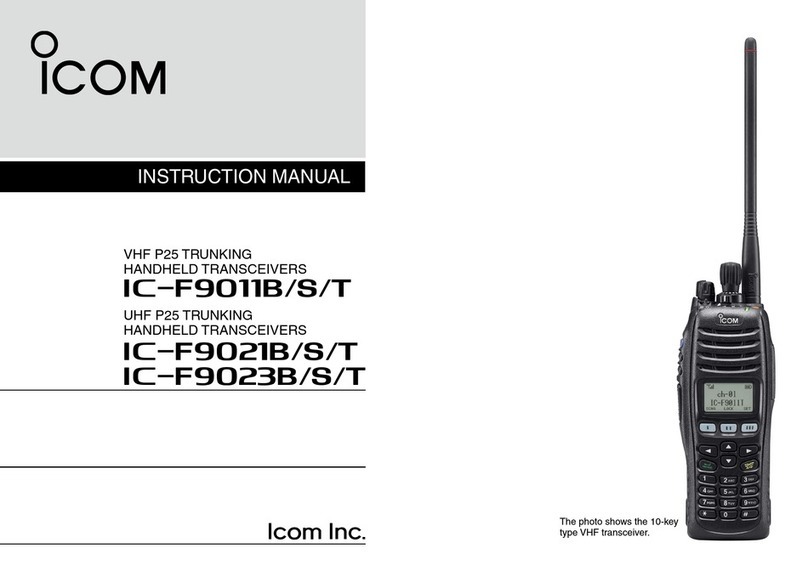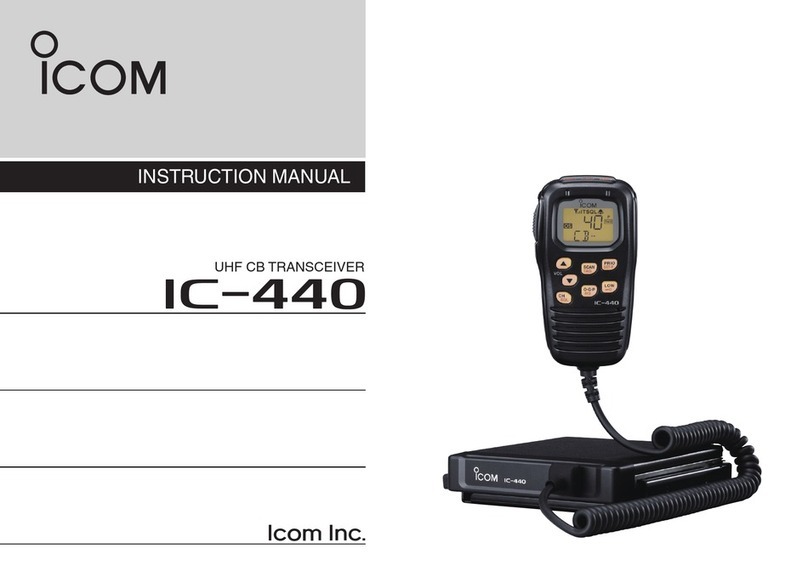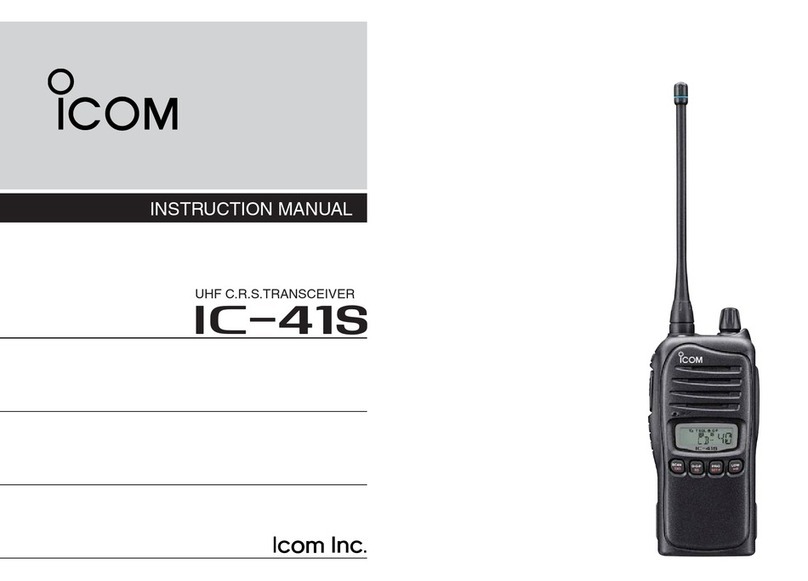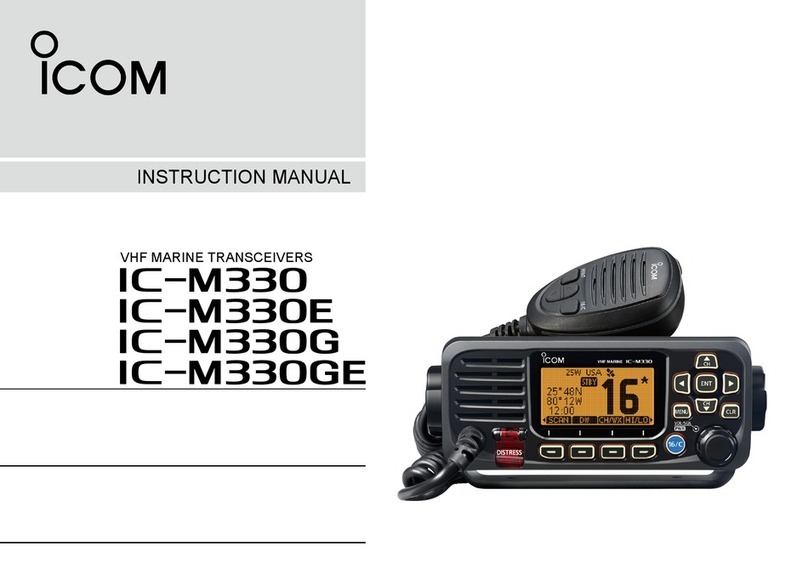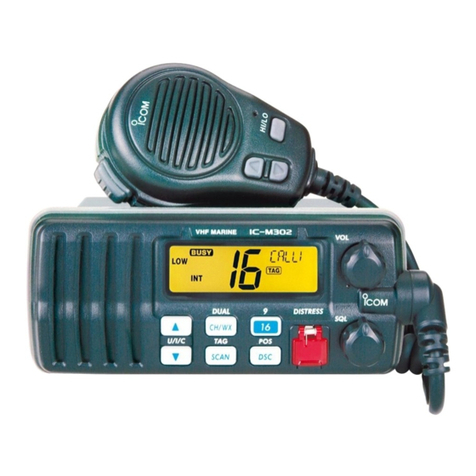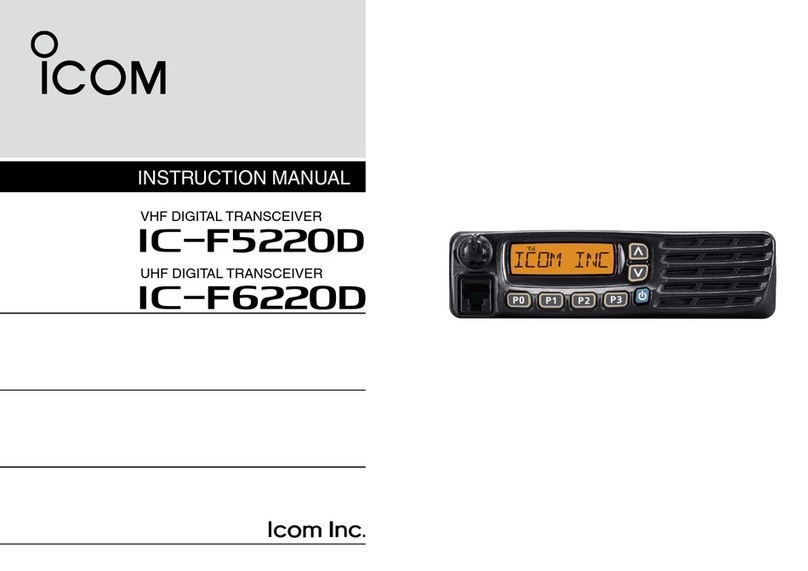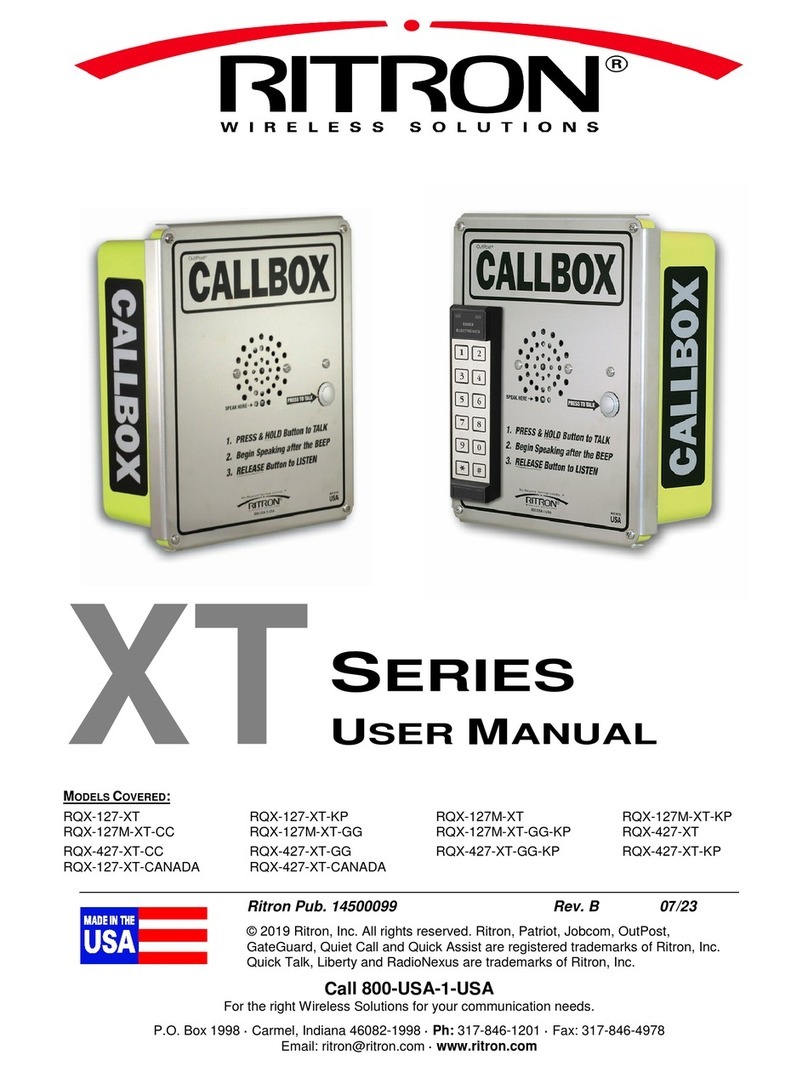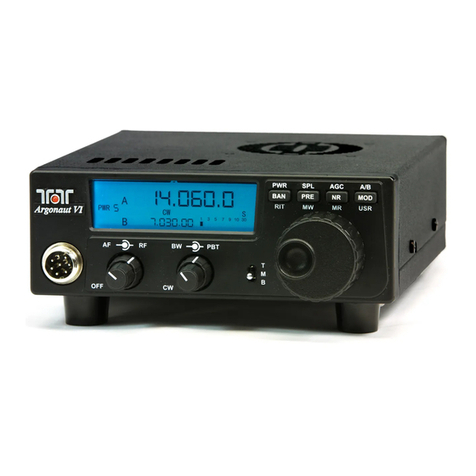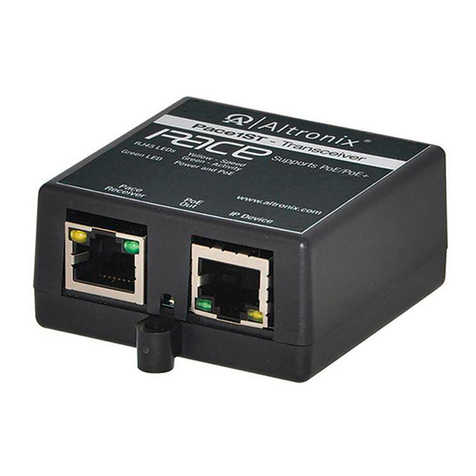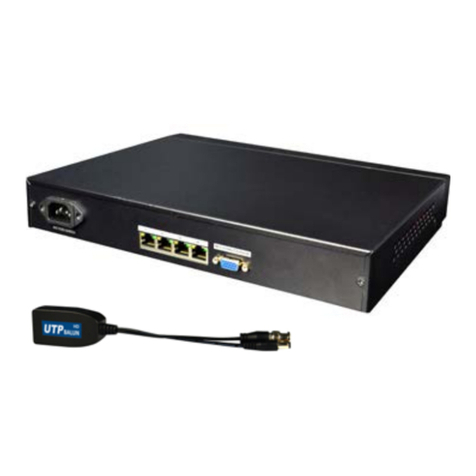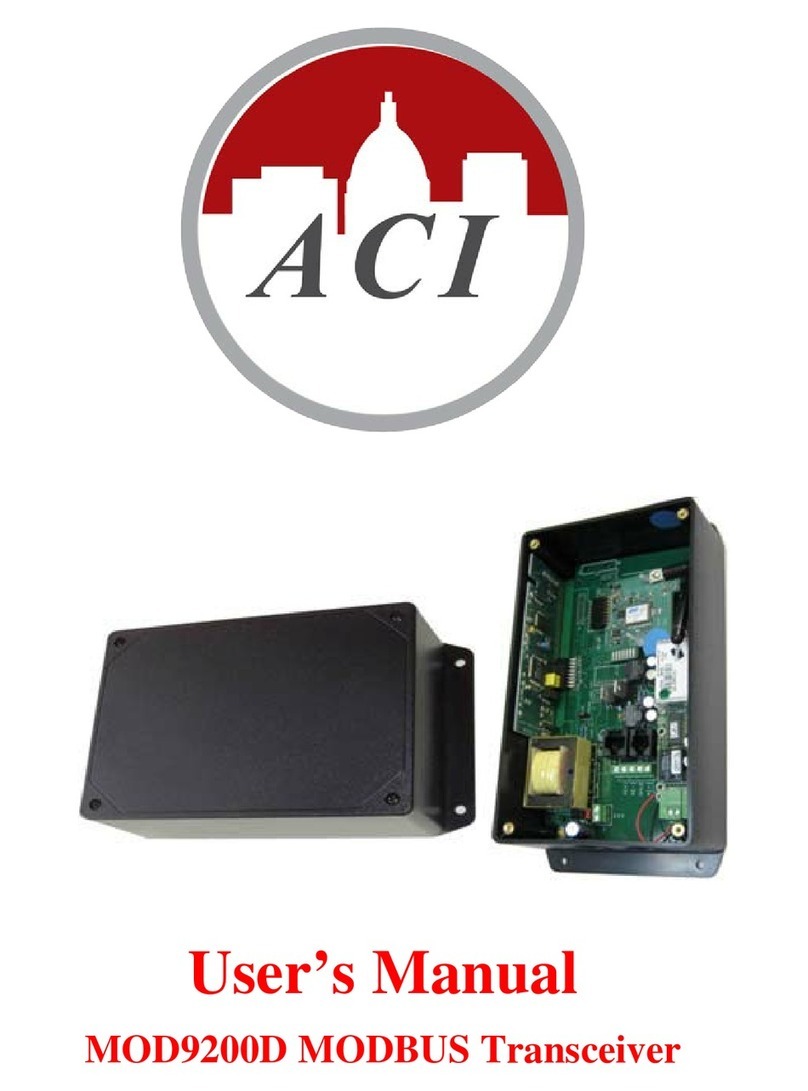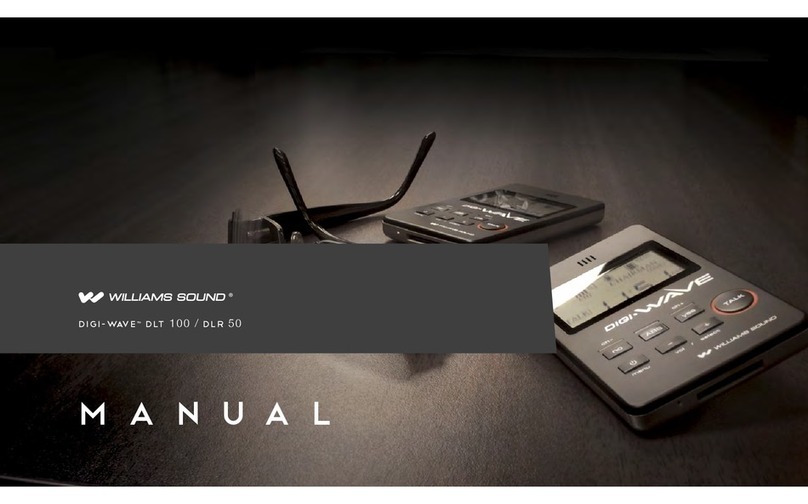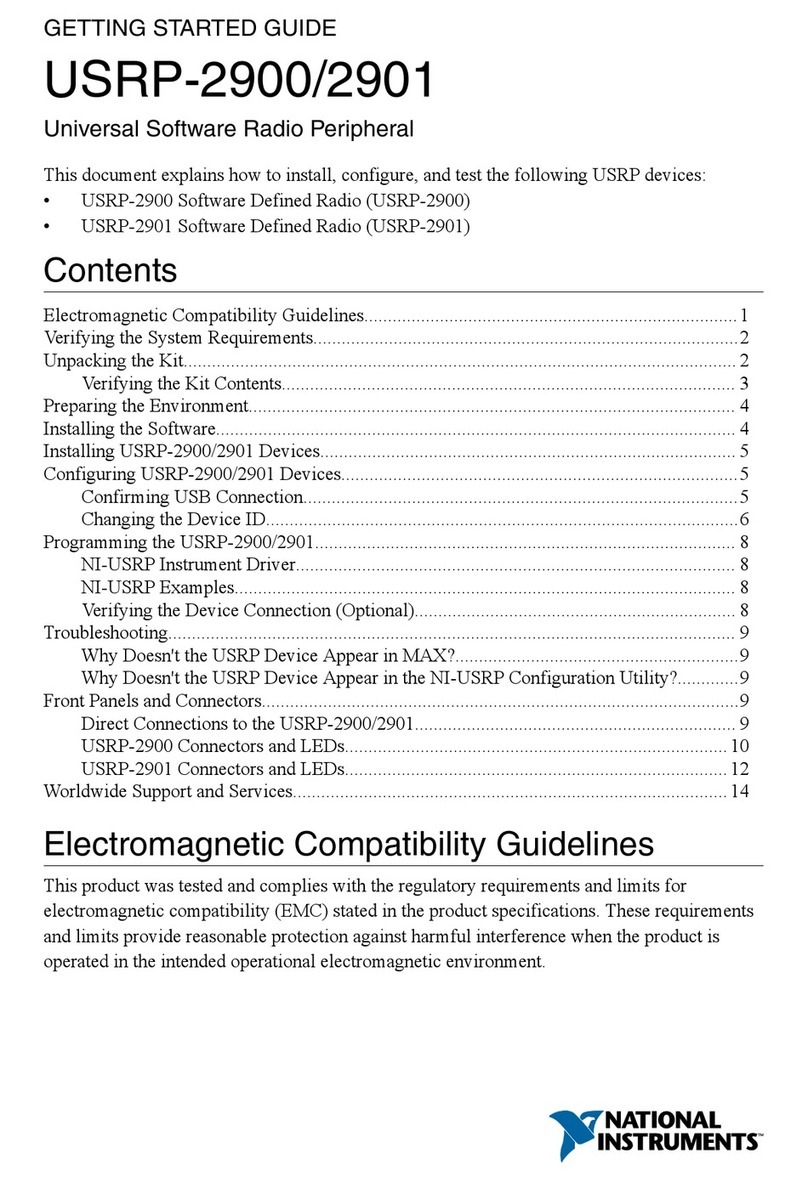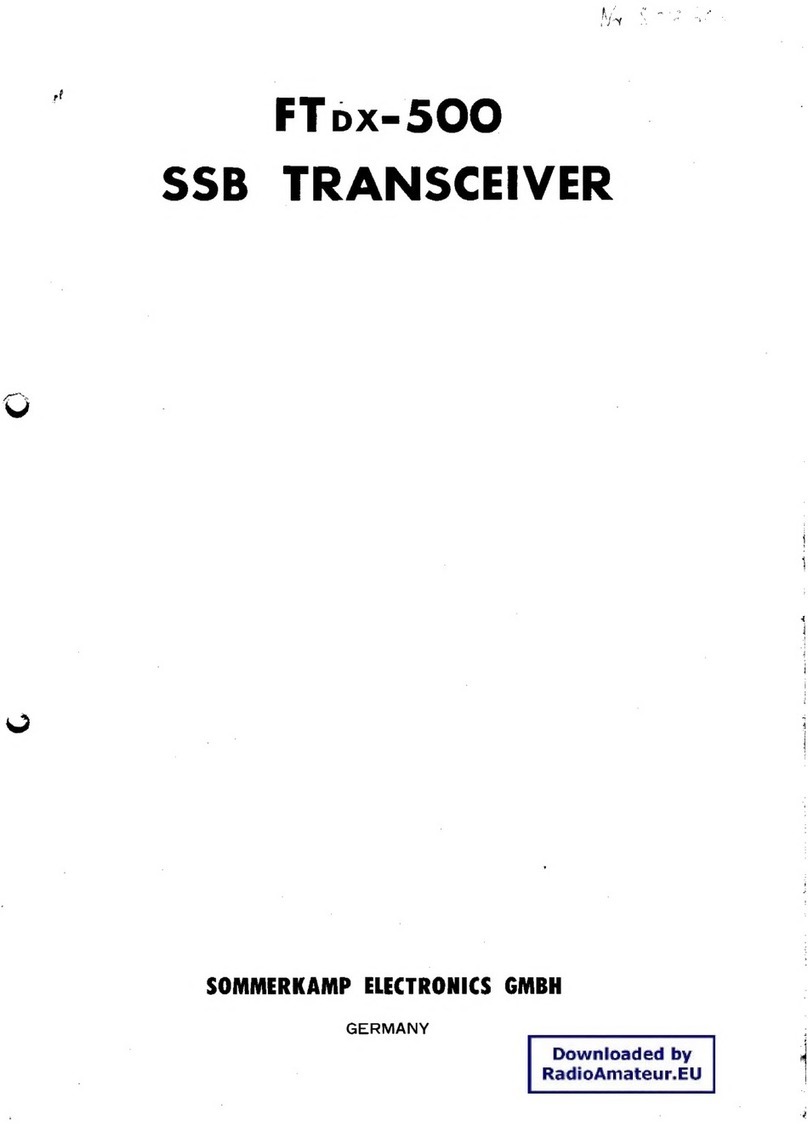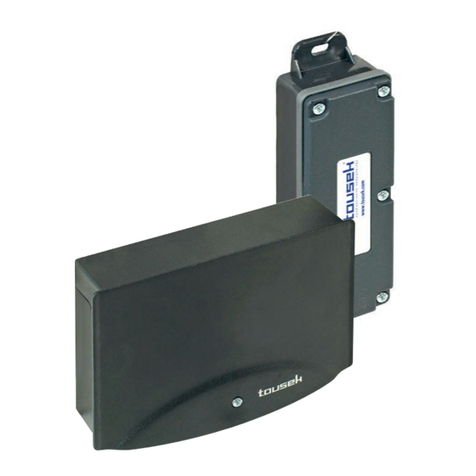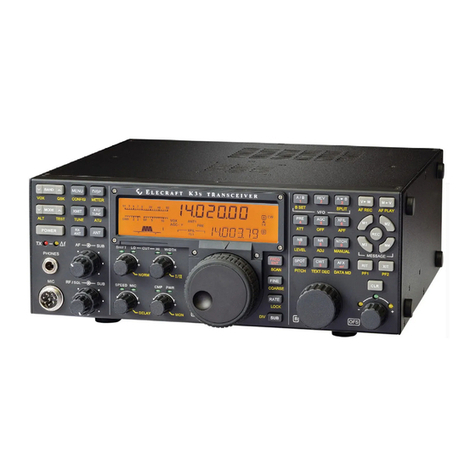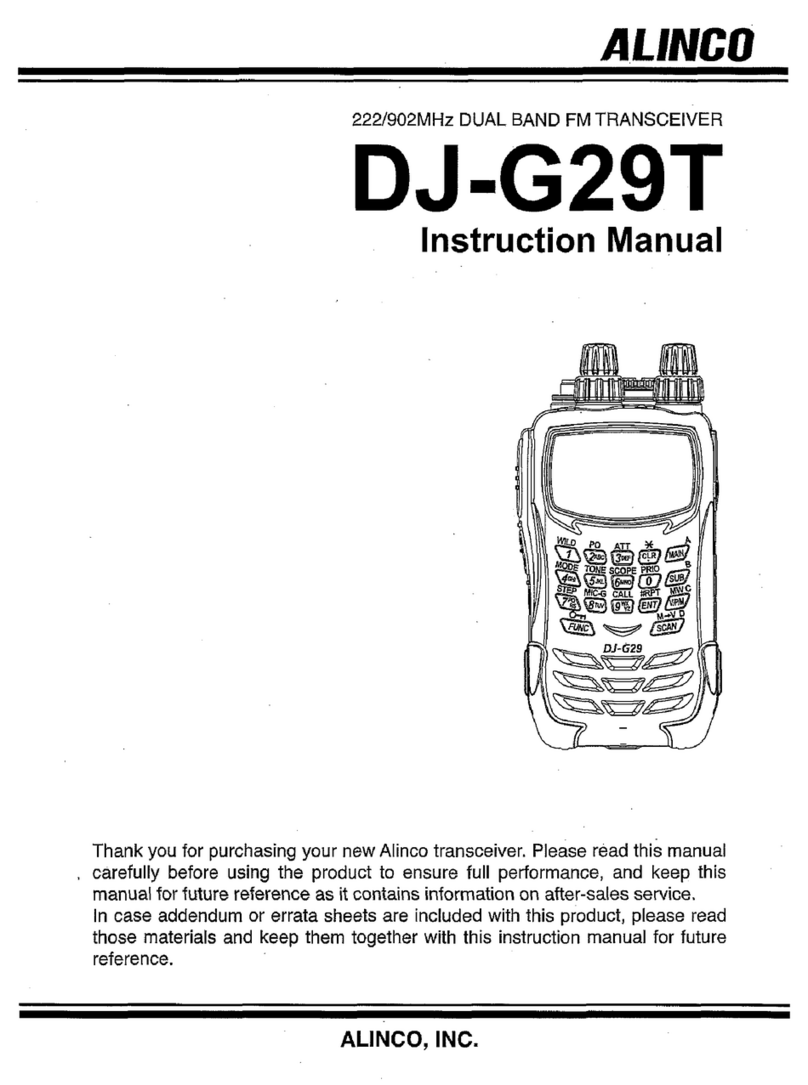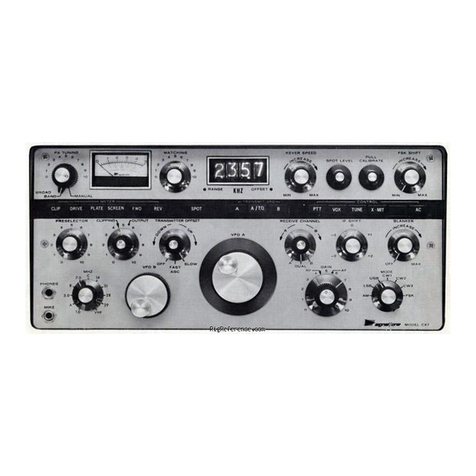Icom IC-A110 User manual

iA110
VHF AIR BAND TRANSCEIVER
INSTRUCTION MANUAL
This device complies with Part 15 of the FCC
Rules. Operation is subject to the condition that
this device does not cause harmful interference.

PRECAUTIONS
i
RWARNING! NEVER operate the transceiver with a
headset or other audio accessories at high volume levels.
Hearing experts advise against continuous high volume op-
eration. If you experience a ringing in your ears, reduce the
volume level or discontinue use.
RWARNING! NEVER connect the transceiver to an
AC outlet or to a power source of more than 27.5 V DC, or
use reverse polarity. This could cause a fire or damage the
transceiver.
CAUTION: NEVER connect the transceiver to a power
source that is DC fused at more than 5 A. Accidental reverse
connection will be protected by this fuse, higher fuse values
will not give any protection against such accidents and the
transceiver will be ruined.
DO NOT operate the transceiver near unshielded electrical
blasting caps or in an explosive atmosphere.
Always place unit in a secure place to avoid inadvertent use
by children.
DO NOT push the PTT switch when you don’t actually de-
sire to transmit.
FOREWORD
READ ALL INSTRUCTIONS carefully and completely
before using the transceiver.
SAVE THIS INSTRUCTION MANUAL —This in-
struction manual contains important operating instructions for
the IC-A110.
EXPLICIT DEFINITIONS
The explicit definitions below apply to this instruction man-
ual.
WORD DEFINITION
RWARNING! Personal injury, fire hazard or electric shock
may occur.
CAUTION Equipment damage may occur.
NOTE If disregarded, inconvenience only. No risk
of personal injury, fire or electric shock.
For Canada:
This device complies with RSS-310 of Industry Canada. Operation is subject to
the condition that this device does not cause harmful interference.
Cet appareil est conforme au CNR-310 d’Industrie Canada. Son exploitation
est autorisée sous réserve que l’appareil ne cause pas de brouillage préjudi-
ciable.

DO NOT use or place the transceiver in areas with tem-
peratures below –30°C (–22°F) or above +60°C (+140°F), or
in areas subject to direct sunlight, such as the dashboard.
DO NOT place the transceiver in excessively dusty envi-
ronments.
DO NOT place the transceiver against walls. This will ob-
struct heat dissipation.
DO NOT use harsh solvents such as benzine or alcohol
when cleaning, as they will damage the transceiver sur-
faces.
BE CAREFUL! The transceiver will become hot when op-
erating continuously for long periods of time.
PRECAUTIONS
ii
FCC caution: Changes or modifications to this transceiver,
not expressly approved by Icom Inc., could void your au-
thority to operate this transceiver under FCC regulations.
TABLE OF CONTENTS
FOREWORD .......................................................................................... i
EXPLICIT DEFINITIONS ........................................................................ i
PRECAUTIONS ...................................................................................... i
TABLE OF CONTENTS ......................................................................... ii
1 PANEL DESCRIPTION ............................................................... 1–3
■Panel description ..................................................................... 1–2
■Function display ........................................................................... 3
2 BASIC OPERATION ................................................................... 4–5
■Power ON .................................................................................... 4
■Channel selection ......................................................................... 4
■Squelch function ........................................................................... 5
■Sidetone function.......................................................................... 5
■LCD backlight control.................................................................... 5
■Dial select function........................................................................ 5
3 SCAN OPERATION .................................................................... 6–7
■Scan operation ............................................................................ 6
■ON-Hook scan ............................................................................. 7
■Dualwatch .................................................................................... 7
4 MEMORY PROGRAMMING ....................................................... 8–9
■Programming a memory channel.................................................. 8
■Memory names............................................................................. 9
5 OTHER FUNCTIONS .............................................................. 10–11
■Initial Set mode .......................................................................... 10
■Cloning ...................................................................................... 11
6 CONNECTION AND INSTALLATION .................................... 12–13
■Rear panel and connections ...................................................... 12
■Mounting .................................................................................... 13
■Supplied accessories.................................................................. 13
7 SPECIFICATIONS .................................................................. 14–15
8 OPTIONS ................................................................................. 16–17
■OPC-871 Headset adapter ......................................................... 16
■Other options .............................................................................. 17
9 FOR CLASS B UNINTENTIONAL RADIATORS ......................... 18
10 SAFETY TRAINING INFORMATION ..................................... 19–20
Icom, Icom Inc. and the Icom logo are registered trademarks of Icom Incor-
porated (Japan) in Japan, the United states, the United Kingdom, Germany,
France, Spain, Russia and/or other countries.

■Panel description
1
1PANEL DESCRIPTION
V/M
SCAN
PRI SQL
qw er
tyuio!0
qTUNING [DIAL] [TS](DIAL)
➥Changes the operating frequency; memory channel in
the Memory mode; set mode contents in the Set mode,
etc.
➥Push to toggle the dimmer control OFF, Low or High.
➥Hold down for 1 second to select the Tuning Step [TS];
1 MHz or 10 kHz are selectable. (p. 5)
wFUNCTION DISPLAY (p. 3)
Displays the operating frequency, memory channel name,
etc.
eVOLUME UP [Y] DOWN [Z] KEY
Adjusts the audio output level.
rLOUD SPEAKER
Front mounted loud speaker.
tPOWER SWITCH [POWER]
Hold down 0.5 seconds to turn the power ON or OFF.
•AtPowerON,theInitialSetmode(p.10)ortheCloningmode
(p. 11) can optionally be selected.

2
1
PANEL DESCRIPTION
ySQL SWITCH [SQL]
➥Push to turn ON the squelch adjust mode. (p. 5)
➥Hold down this switch for 1 second to turn the both in-
ternal and external speaker output ON or OFF. (p. 4)
uPRIORITY SWITCH [PRI]
Push to select the priority channel. (p. 11)
•“Pr”appearsonthedisplay.
iSCAN SWITCH [SCAN]
➥Starts and stops the scan function:
•VFOmode:VFOscanfunction.(p.6)
•Memorymode:Memorychannelscanfunction.(p.6)
➥Hold down this switch for 5 seconds to set the displayed
channel as a memory lockout channel. (p. 8)
•“LOCKOUT”appearsonthedisplay.
oVFO/MEMORY SWITCH [V/M] [MW](V/M)
➥ Push to toggle between the VFO mode and the Memory
mode. (p. 4)
•“X”andmemorychannelnumberappearwhentheMemory
mode is selected.
•Thetransceiverhas99memorychannels.
➥ When the VFO mode is selected;
•Holddownthisswitchfor5secondstoentertheVFOfre-
quency into the memory channel. (p. 8)
➥ When the Memory mode is selected;
•Holddownthisswitchfor5secondstoturnONthe“Memory
namewritemode.”(p.9)
!0 MICROPHONE CONNECTOR
Connects to the supplied microphone or optional.
NEVER connect other microphones. The pin assignments
may be different and the transceiver may be damaged.
MICROPHONE
The supplied microphone has a PTT switch and a cradle.
The following functions are available when the microphone is
taken off the hook or put back on the hook:
➥Automatic scan starts when the microphone is put ON Hook.
(p. 7)
➥Automatic scan stops when the microphone is taken OFF
Hook. (p. 7)
NOTE: Optional functions vary with transceiver version.
In this manual, optional functions are indicated by an
“”Icon.
Please contact your dealer for details.

3
1PANEL DESCRIPTION
■Function display
qMEMORY MODE INDICATOR (p. 4)
Appears when the Memory mode is selected.
wDUALWATCH INDICATOR (p. 7)
Appears when the dualwatch function is activated.
eSCAN INDICATOR (p. 6)
Appears when the scan function is selected.
rBUSY INDICATOR (pp. 4, 5)
Appears when receiving a signal or when the squelch is
open.
tTX INDICATOR (p. 4)
Appears while transmitting.
yFREQUENCY DISPLAY
➥Shows the operating frequency. (p. 4)
➥ Shows the channel name when the memory name func-
tion is selected. (p. 10)
uVOLUME LEVEL INDICATORS
Shows the AF volume level (while receiving).
iSET MODE INDICATOR (p. 10)
Appears when the Initial Set mode is selected.
oLOCK OUT INDICATOR (p. 8)
Appears when the channel is set as a ‘LOCK OUT’ chan-
nel.
!0 MEMORY CHANNEL INDICATOR
➥Displays the selected memory channel number
➥“Pr”appearswhentheprioritychannelisselected.
*NOTE: The VFO/memory switch [V/M] and the memory
write switch [MW](V/M) functions may not be available,
depending on the version.
wqrt
!0
e
oiu
y

4
2
BASIC OPERATION
■Power ON
qPush [POWER] to turn ON the power.
wOperate the transceiver as described in the following sec-
tions.
eSelect the desired memory channel (or VFO frequency)
with the [V/M] keys.
•Whenreceivingasignal,“ ”appearsandaudioisheard
from the speaker.
•Furtheradjustmentoftheaudiolevelmaybenecessaryatthis
point.
•Push[SQL]toadjustthesquelchlevel.(p.5)
•Holddown[TS](DIAL)for1secondtoselectthetuningstep.
1 MHz or 10 kHz are selectable. (p. 5)
rHold down [PTT] to transmit, then speak into the micro-
phone at your normal voice level.
•Transmitindicator“ ”lights.
tRelease [PTT] to receive.
■Channel selection
ï VFO/Memory selection
Push [V/M] to select the Mem-
ory mode or the VFO mode.
➥ Rotate [DIAL] to select a de-
sired frequency or channel.
ï External speaker output control
External speaker output can be turned OFF, if desired.
qHolddown[SQL]for1second.
wRotate[DIAL]toselect“SPOFF”.
ePush[SQL]toreturntothepreviousmode.
NOTE: This function is avail-
able for both internal and ex-
ternal speakers.

5
2BASIC OPERATION
■Squelch function
The transceiver has a noise squelch circuit to mute undesired
noise while receiving no signals.
DSetting the squelch level
qPush[SQL]toturnONtheleveladjustingmode.
w Rotate [DIAL] to select the squelch level.
•‘SQ01’isloosesquelchand‘SQ25’istightsquelch.(Initial
levelis‘SQ01’)
•‘SQ01’indicatesthatthesquelchcircuitisturnedoff.
•“ ”appearsonthedisplay.
ePush[SQL]toreturntoregularoperation.
■Sidetone function
When using an optional headset, such as those from the
David Clark Co. using the OPC-871 HEAD SET ADAPTER, the
transceiver outputs your transmitted voice to the headset for
monitoring. (p. 16)
■LCD backlight control
The backlight of the LCD can be set to OFF, Low or High.
➥Push [DIAL] to toggle the backlight control; OFF, Low or
High are selectable.
■Dial select function
Use the dial select function to adjust the tuning steps of the
[DIAL] keys. Use 1 MHz tuning when you want to change the
frequency in large increments; use regular tuning (25 kHz or
8.33 kHz) when you want to change the frequency in smaller
increments.
qPush [V/M] to select VFO
mode.
wHold down [TS](DIAL) for 1
second to select the desired
tuning increment.
•1MHztuningorregulartuning
steps can be selected. (see the
diagrams to the right)
eHold down [TS](DIAL) for 1
second to return to normal
operation.
NOTE: Large tuning steps should be used only when you
want to change the frequency in large increments. Please
select regular tuning steps for normal operation.
1 MHz tuning selected
Regular tuning selected

6
3
SCAN OPERATION
■Scan operation
qPush [V/M] to select the Memory mode or the VFO mode,
if necessary.
•“X”appearswhenintheMemorymode.
wMake sure the squelch level is set to the threshold point.
•Setthesquelchlevel(01to25)wherethenoiseisjustmuted.
ePush [SCAN] to start the scan.
•Tochangethescandirection,turn[DIAL].
•“SCAN(orPSCAN)”asheswhilescanning.
rPush [SCAN] again to stop the scan.
NOTE: Normal scan or Priority scan is pre-programmed
by cloning. Please ask your dealer or system operator for
details.
ï NORMAL SCAN
•Memory lock scan
Repeatedly scans memory
channels except skip (lockout)
channels.
•VFO scan
Repeatedly scans all fre-
quencies over the entire
band.
Scan step is minimum chan-
nel spacing. (e.g. 25 kHz or
8.33 kHz)
ï PRIORITY SCAN
• Priority memory scan
While scanning in the
Memory mode, priority
watch checks for a sig-
nal on the selected priority
channel every 250 millisec-
onds, and skips the lockout
channel(s).
Mch 2*
Mch 1
Mch 3
Mch 99
250 msec.
SKIP
*: Lockout ch
Scan
Jump
Start highest
frequency
lowest
frequency
Priority
ch
Mch 2*
Mch 1
Mch 3
Mch 99
250 msec. 250 msec.
SKIP
*: Lockout ch

7
3SCAN OPERATION
■ON–Hook scan
An ON–Hook scan (Hanger scan) stops when taking the mi-
crophone off its hanger (OFF–Hook) and resumes when put-
ting it back on the hanger (ON–Hook).
➥Push [SCAN] to start scanning.
•Whenasignalisreceived,thescanpausesuntilthesignaldis-
appears.
•Thescanresumes2secondsafterthesignaldisappears,unless
you pushed [PTT] and transmitted.
•Takethemicrophoneoffthehangertostopthescan.
•Putthemicrophonebackonthehangertoresumescan-
ning.
When you take the microphone OFF Hook during the scan
operation.
•InVFOscan;
the scan stops on the last frequency that was scanned.
•Inmemoryscan;
the scan stops on the last memory channel that was
scanned.
•Inprioritymemoryscan;
the scan stops on the priority channel.
NOTE: Be sure to connect the supplied microphone
hanger to the vehicle’s ground for ON and OFF Hook mi-
crophone functions. (p. 12)
■Dualwatch
Dualwatch monitors the priority channel while you are receiv-
ing another channel (VFO or memory channel).
•Ifasignalisreceivedonthe
priority channel, dualwatch
pauses on the priority chan-
nel until the signal disap-
pears.
•Totransmitontheselected
channel during dualwatch,
hold down [PTT].
See page 11 for details of the priority channel setting.
ï Operation
qSelect the desired operating channel (VFO or Memory
channel).
wHold down [PRI] for 1 second to start dualwatch.
•“P”blinksduringdualwatch.
eTo cancel dualwatch, push [PRI] again.
VFO
frequency
or
memory
channel
Priority
channel
5 sec.
250 msec.

8
4
MEMORY PROGRAMMING
DSetting lockout channels
In order to speed up the scan periods, you can set memory
channels you don’t wish to be scanned as lockout channels.
qPush [V/M] to select the Memory mode, if necessary.
•“X”appears.
wRotate [DIAL] to select a memory channel to set as a lock-
out channel.
eHold down [SCAN] for 5 sec-
onds to toggle the lockout
setting ON or OFF.
•“LOCK OUT” appears when
the channel is set as a lockout
channel.
The transceiver has 99 memory channels for storage of of-
ten-used frequencies.
qPush [V/M] to select the VFO
mode, if necessary.
wRotate [DIAL] to select the
desired frequency.
•Push[TS](DIAL)oneormore
times to use the dial select
function, if desired.
eHold down [MW](V/M) for 5
seconds to enter memory
programming mode.
•“X” and memory channel
number appear.
rRotate [DIAL] to select the
desired memory channel
number.
tHold down [MW](V/M) for 1
second to program the infor-
mation into the channel and
return to VFO mode.
•Toclearthememoryinforma-
tion,holddown[SQL]for1sec-
ond.
MR
MR
MR
BUSY
SKIP
50
*NOTE: The VFO/memory switch [V/M] and the memory
write switch [MW] functions may not be available, de-
pending on version.
Memory channel 8 is set
as a lockout channel.
■Programming a memory channel

9
4MEMORY PROGRAMMING
■Memory names
ï Programming memory names
qSelect the memory channel to be programmed:
➥ Push [V/M] to select the Memory mode.
➥ Rotate [DIAL] to select the memory channel.
wHold down [MW](V/M) for 5 seconds to enter memory
name writing mode.
•Therstdigitblinks.
eRepeatedly rotate [DIAL] to select the desired character.
•Toeraseacharacter,overwritewithaspace(displayedas_).
•Tomovethecursorforwardsorbackwards,push[Y] or [Z].
•Holddown[SQL]for2secondstoeraseallcharacters.
rHold down [MW](V/M) for 1 second to input the entered
name.
•Thecharacterstopsblinking.
•Memorychannelscanbeprogrammedwithnamesofupto7
characters in length.
•Whennonameisprogrammed,thedisplayshowstheoperating
frequency.
NOTE: Push [PTT] to cancel the memory name programming.
•Thefollowingcharacterscanbeusedinnames:
➥ 0 to 9, A to Z (capitals), (space), $, %, ’, (, ), ✽, +, “ ,
”, –, /, <, =, >, ?, @, [, \, ], ^, _ and `.
V/M
for 5 seconds
V/M
for 1 second
+or
[EXAMPLE]:Settingthenameto“TOWER2”

5
OTHER FUNCTIONS
10
■Initial Set mode
The Initial Set mode is entered at Power ON and allows you
tosetseldom-changedsettings.Inthiswayyoucan“custom-
ize”thetransceiveroperationstosuityourpreferencesand
operating style.
DEntering Initial Set mode
qWhile holding down [V/M] + [TS](DIAL), push [POWER] to
turn ON the power.
•ThetransceiverenterstheInitialSetmodeand“MN”,“BP”,“ST”
or“PR”(p.11)appearsonthedisplay.
wPush [TS](DIAL) to select the
desired item as described below
and to the right.
eRotate [DIAL] to select the de-
sired option or setting.
rTurn OFF the power, then ON
again to exit the Initial Set mode
and return to the previous oper-
ating mode.
DMemory names
This item allows you to display a memory name instead of
the frequency.
•Whenamemorychannelhasnotbeenprogrammedwitha
name, the frequency appears instead.
DBeep tones ON/OFF
Confirmation beep tones normally
sound when you push a key.
These can be turned ON or OFF,
as you prefer.
DSidetones ON/OFF
When using an optional head-
set such as those from the David
Clark Co. using an the adapter,
the transceiver outputs your trans-
mitted voice to the headset for
monitoring.
• Optional OPC-871 HEADSET
ADAPTER is required.

OTHER FUNCTION
5
11
DPriority channel
The priority channel is used to store your most often-used
channel for quick recall. In addition, the priority channel is
monitored during priority scan modes. The default setting for
the priority channel will differ, depending on pre-program-
ming.
➥Push [PRI] to toggle the prior-
ity channel mode or the previous
mode.
•Setting the priority channel
qWhile holding down [V/M] and [TS](DIAL), push [POWER]
to turn ON the power.
•ThetransceiverenterstheInitialSet
mode.
wPush [TS](DIAL) to select the pri-
ority channel Set mode.
eRotate [DIAL] to select the desired
channel number as a priority chan-
nel or OFF.
rHold down [POWER] to turn OFF
the power.
NEVER select the blank memory channel as the priority
channel. In such a case the priority function is automati-
cally set to the OFF position.
■Cloning
DData cloning
Data can be cloned to and from a PC using the optional CS-
A110EURO CLONING SOFTWARE and the optional OPC-478 CLON-
ING CABLE+OPC-592 CLONING CABLE ADAPTER.
Consult the CS-A110EURO CLONING SOFTWARE HELP message
for details.
DCloning error
When the display to the right appears,
a cloning error has occurred.
In this case, transceiver automatically
return to the clone standby mode and
cloning must be repeated.

w
q
e
r
t
black: _
red: +
External speaker jack
OPC-871 HEADSET
ADAPTER (Option)
Antenna
Supplied DC
power cable
12 V or 24 V
Battery
12 V or 24 V
Battery
RWARNING! NEVERremove the fuse-
holders from the DC power cable.
(Depending on version, the fuse holder
may not be attached to the black cable.)
Solder
Crimp
NOTE: Use the termi-
nals as shown for the
cable connections.
6
CONNECTION AND INSTALLATION
12
■Rear panel and connections
qConnects to an antenna
Ask your dealer about antenna selection and best installa-
tion location. (Standard 50 Ωantenna with an SWR <3.0)
wMICROPHONE HANGER
Connect the supplied microphone hanger to the vehicle’s
ground to use the hanger scan function when hanging or
removing the microphone.
eDC POWER RECEPTACLE
Connects to a 12 or 24 V DC battery. Pay attention to po-
larities.
RWARNING! NEVER connect to a over 27.5 V battery.
This could damage the transceiver.
rEXTERNAL SPEAKER JACK
Connect an 8 Ω, 30 W (Min.) external speaker, if desired.
CAUTION: DO NOT use an external speaker whose
power input rating is less than 30 W or whose impedance
is less than 8 Ω. Using a speaker of less than 30 W power
rating, or less than 8 Ωimpedance, could cause damage
to the external speaker or to the transceiver itself.
tOPC-871 OPTIONAL HEADSET ADAPTER
Connect an optional headset. (See p. 16)

13
6CONNECTION AND INSTALLATION
■Mounting
The universal mounting bracket supplied with your trans-
ceiver allows overhead or dashboard mounting. Please read
the following instructions carefully.
•Mountthetransceiversecurelywiththe4suppliedscrews
(M5 ×20) to a surface which is more than 10 mm thick and
can support more than 5 kg.
•Mountthetransceiversothatthefaceofthetransceiveris
at 90˚ to your line of sight when operating.
■Supplied accessories
qMicrophone ���������������������������������������������������������������������������������1
wMicrophone hanger and screw set ��������������������������������������� 1 set
eMicrophone cable �����������������������������������������������������������������������1
rDC power cable (OPC-344) �������������������������������������������������������1
tMounting bracket ������������������������������������������������������������������������1
yBracket bolts �������������������������������������������������������������������������������4
uMounting screws (M5 × 12) ��������������������������������������������������������4
iSelf-tapping screws (M5 ×20) ����������������������������������������������������4
oFlat washers��������������������������������������������������������������������������������4
!0 Spring washers ���������������������������������������������������������������������������4
!1 Nuts ��������������������������������������������������������������������������������������������4
!2 Fuses (10 A) �������������������������������������������������������������������������������2
qw
e
r
ty
u
i
o!0 !1 !2
Flat washer
Spring washer
When using
self-tapping screws

14
7
SPECIFICATIONS
DGeneral
•Frequencycoverage :118to136.975MHz
•Channelspacing :25/8.33kHz
•Mode :AM(6K00A3E/5K6A3E)
•
Number of memory channels
: 99
•Acceptablepowersupply :13.75†V or 27.5†V DC
(negative ground) †Automatic selection
•Usabletemp.range :–30˚Cto+60˚C
•Frequencystability :±5ppm
•Currentdrain
(at 13.75 V DC)
:
Tx 5 A (max.)
Rx 4 A ( at AF max.)
0.5 A (at STANDBY)
•Dimensions :150 (W) ✕ 50 (H) ✕ 180 (D) mm
(projections not incl.)
5.9(W) ✕ 2(H) ✕ 7.1(D) in
•Weight(approximately) : 1.5 kg; 3 lb 5 oz
DTransmitter
•Outputpower :36W(pep) typical
9 W (carrier) typical
•Modulation :LastStagemodulation
•Modulationlimiting :70%to100%
•Audioharmonicdistortion :Lessthan10%
(at85%modulation)
•Humandnoiseratio :Morethan40dB
•Spuriousemissions :–16dBmorless
•Antennaimpedance :Standard50Ωwith SWR <3
DReceiver
•Receivesystem :Doubleconversion
superheterodyne
•Intermediatefrequencies :1st 38.85MHz
2nd 450 kHz
•Sensitivity(at 6 dB S/N) : Less than 1 µV (pd)
•Squelchsensitivity :Lessthan0.35µV(pd)
(at threshold)
•Selectivity
25kHzch.spacing :Morethan±8kHz(at–6dB)
Lessthan±17kHz(at–40dB)
Lessthan±25kHz(at–60dB)
8.33kHzch.spacing Morethan±2.778kHz(at–6dB)
Lessthan±7.37kHz(at–60dB)
•Spuriousresponserejc, :Morethan74dBµ
•Audiooutputpower :Morethan10W(at13.75V
DC with 8 Ωload60%MOD.
10%distortion)
Sidetone
More than 100 mW (with 500 Ω
load60%MOD.10%distortion)
•Humandnoise :Morethan25dB
•Audiooutputimpedance :Ext.SP8Ω
Sidetone 500 Ω
All stated specifications are subject to change without notice
or obligation.

15
7SPECIFICATIONS (VFO CHANNEL ID LIST)
• Channel spacing: 25 kHz (Actual frequency is displayed.)
Operating Frequency
(MHz)
Channel spacing
(kHz)
Channel ID*
(Displayed Frequency)
118.0000 25 118.000
118.0250 25 118.025
118.0500 25 118.050
118.0750 25 118.075
118.1000 25 118.100
• Channel spacing: 8.33 kHz
Operating Frequency
(MHz)
Channel spacing
(kHz)
Channel ID*
(Displayed Frequency)
118.0000 8.33 118.005
118.0083 8.33 118.010
118.0167 8.33 118.015
118.0250 8.33 118.030
118.0333 8.33 118.035
118.0417 8.33 118.040
118.0500 8.33 118.055
118.0583 8.33 118.060
118.0667 8.33 118.065
118.0750 8.33 118.080
118.0833 8.33 118.085
118.0917 8.33 118.090
118.1000 8.33 118.105
• Channel spacing: 25/8.33 kHz auto selection mode
Operating Frequency
(MHz)
Channel spacing
(kHz)
Channel ID*
(Displayed Frequency)
118.0000 25 118.000
118.0000 8.33 118.005
118.0083 8.33 118.010
118.0167 8.33 118.015
118.0250 25 118.025
118.0250 8.33 118.030
118.0333 8.33 118.035
118.0417 8.33 118.040
118.0500 25 118.050
118.0500 8.33 118.055
118.0583 8.33 118.060
118.0667 8.33 118.065
118.0750 25 118.075
118.0750 8.33 118.080
118.0833 8.33 118.085
118.0917 8.33 118.090
118.1000 25 118.100
118.1000 8.33 118.105
These tables show just the display example between 118.0000 MHz
and 118.1000 MHz, not show all frequencies in the band.
*The Channel IDs are displayed according to RTCA/DO-186B stan-
dards.

16
8
OPTIONS
■OPC-871 Headset adapter
When using a headset (supplied from 3rd party) with an
adapter, the transceiver outputs your transmitted voice to the
headset for monitoring. (pp. 5, 10)
DInstallation
The optional OPC-871 HEADSET ADAPTER is installed as
follows.
qTurn OFF the power, then disconnect the DC power
cable.
wUnscrew the 4 screws, then remove the bottom cover.
(Fig. 1)
eInsert the connector as shown below. (Fig. 2)
rMount the phone plug attachment together with the mobile
mounting bracket with 2 supplied screws. (Fig. 3)
PTT switch
Use a PTT switch with a
3.5 mm diameter plug, if
required.
DConnection
Fig. 1
HEADSET
(Purchase sepa-
rately.)

17
8OPTIONS
•Usetheuppersidemountinghole.
•Youcanmounttheattachmentoneithersideofthetrans-
ceiver.
•Bendtheplasticdustcoverdownbeforeinstallingthestrain
relief into the notch.
Fig. 2
Fig. 3
■Other options
OPC-871 HEADSET ADAPTER (Also see p. 16)
CS-A110EURO
CLONING SOFTWARE
Provides quick and easy programming of items, including pri-
vate channels, scan settings, etc. to the transceiver, using a
PC.
OPC-478
CLONING CABLE
OPC-592
CLONING CABLE ADAPTER
These three components work as one set and provide for
quick and easy programming of items, including memory
channels, memory names and set mode contents, etc. with
a PC.
Approved Icom optional equipment is designed for optimal perfor-
mance when used with an Icom transceiver.
Icom is not responsible for the destruction or damage to an Icom
transceiver in the event the Icom transceiver is used with equipment
that is not manufactured or approved by Icom.
Other manuals for IC-A110
4
Table of contents
Other Icom Transceiver manuals
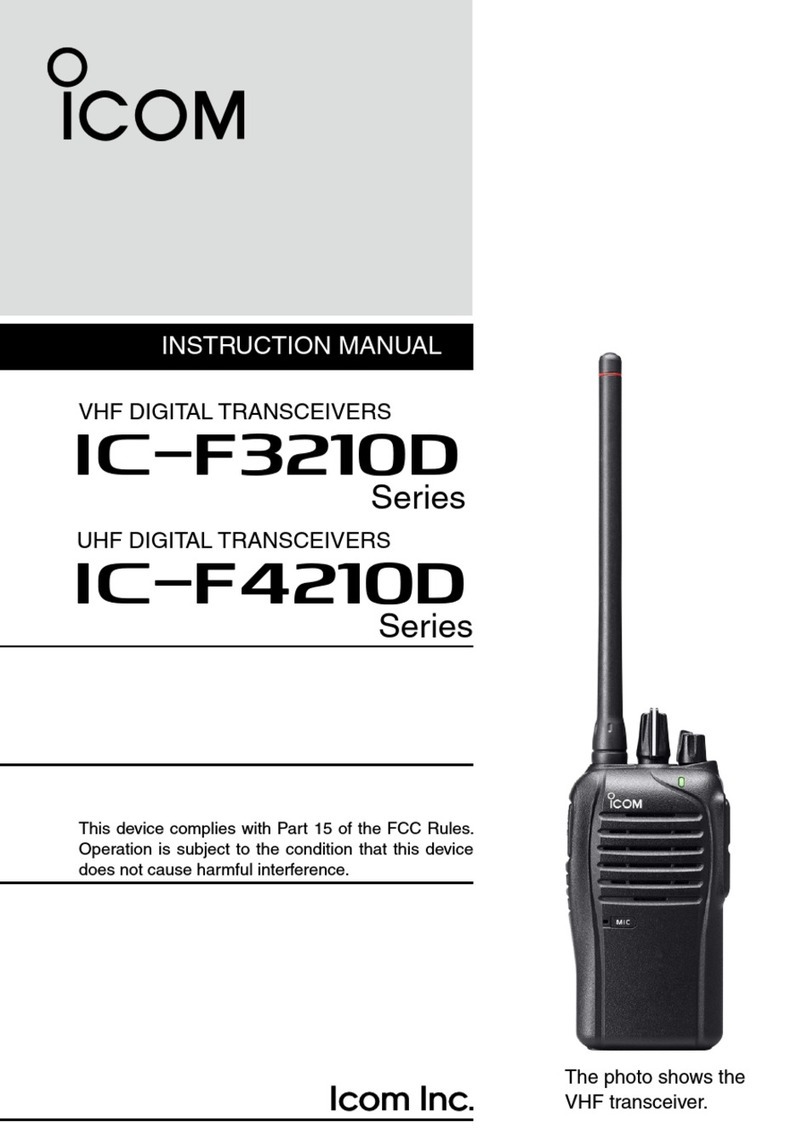
Icom
Icom IC-F3210D Series User manual
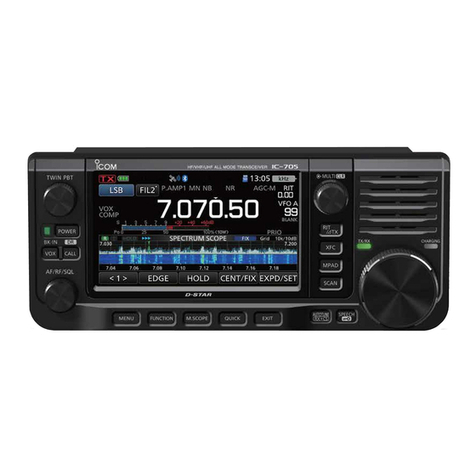
Icom
Icom IC-705 Setup guide
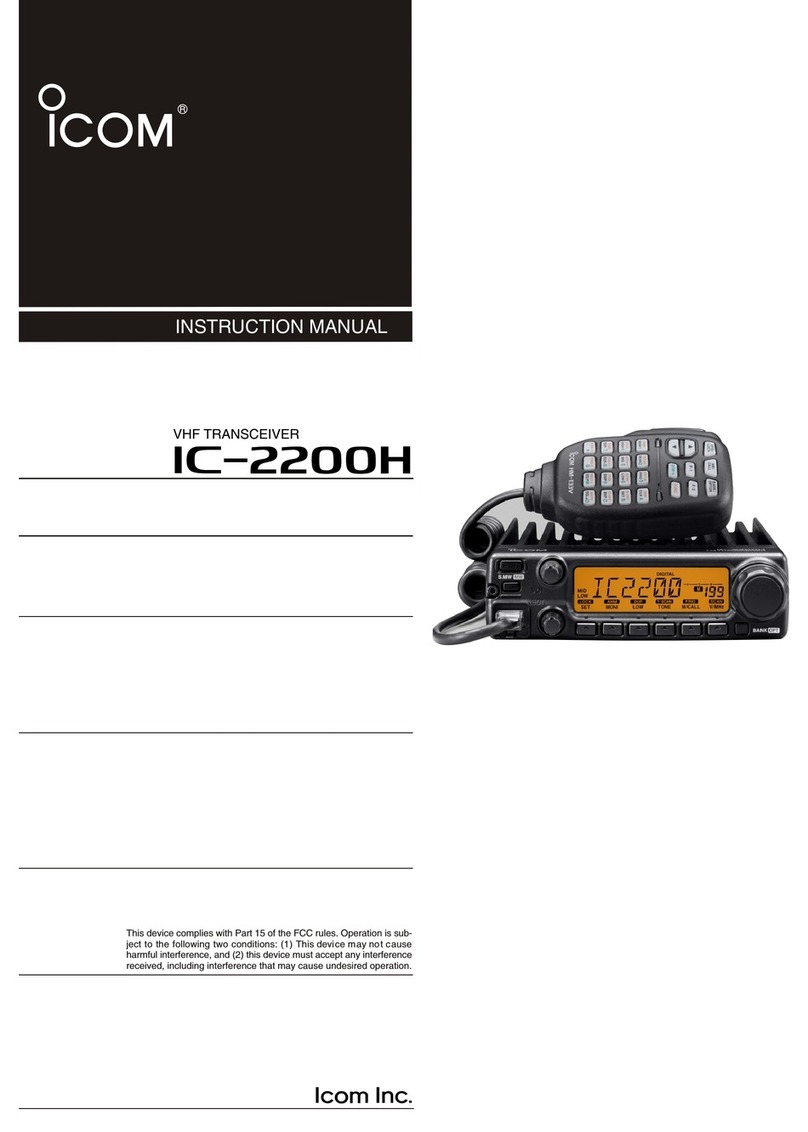
Icom
Icom IC-2200H User manual
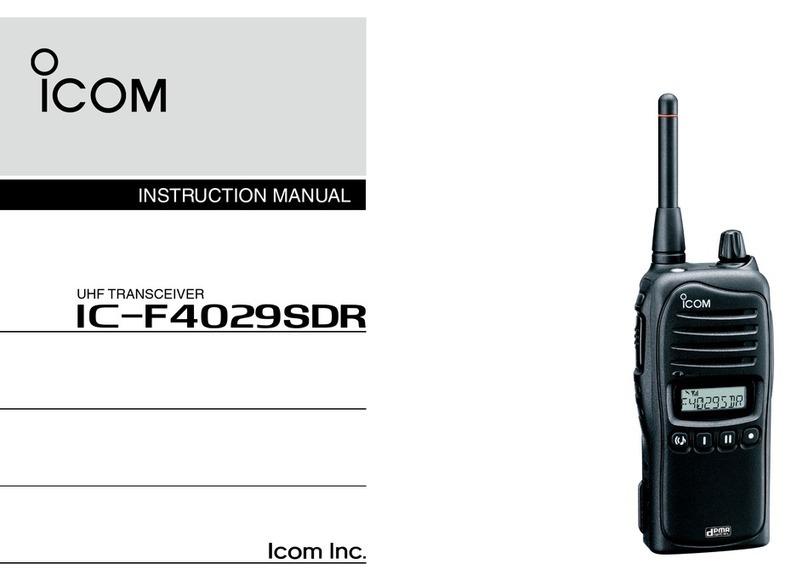
Icom
Icom iF4029SDR User manual
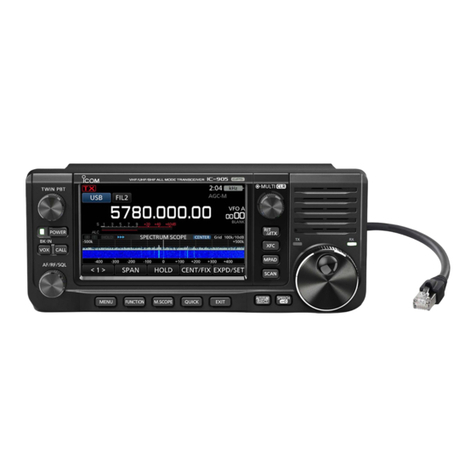
Icom
Icom IC-905 Setup guide
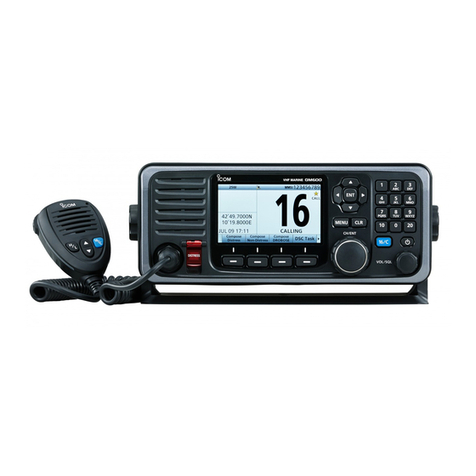
Icom
Icom GM600 Installation guide
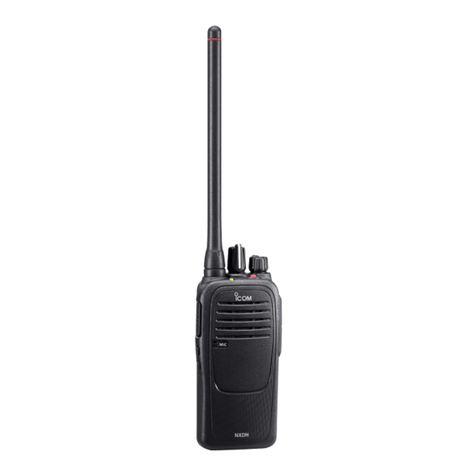
Icom
Icom F2000D 01 User manual
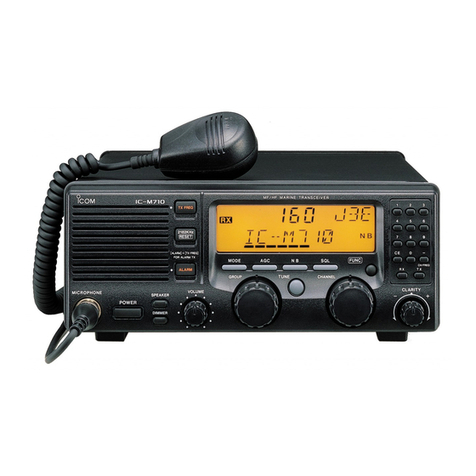
Icom
Icom IC-M710 User manual
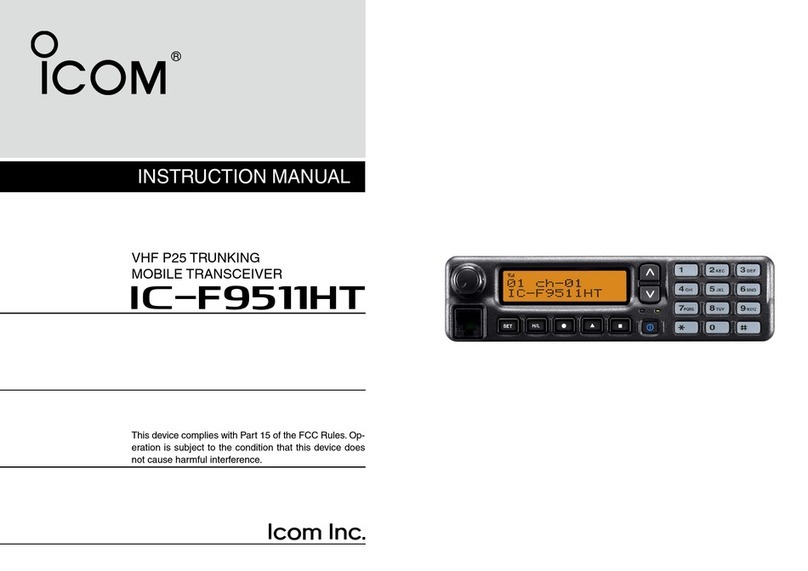
Icom
Icom IC-F9511HT User manual
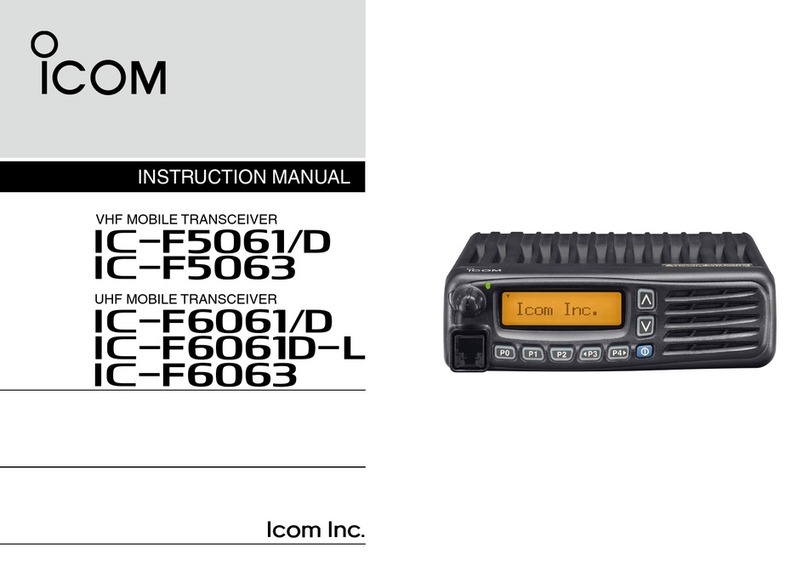
Icom
Icom iF5061D User manual
